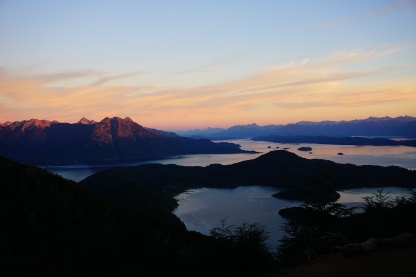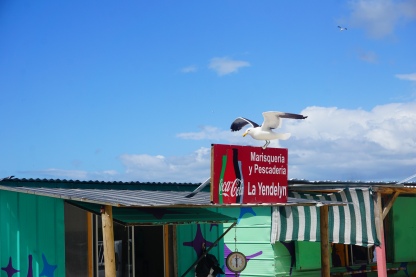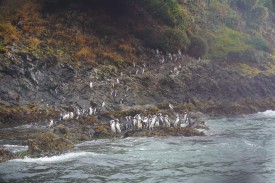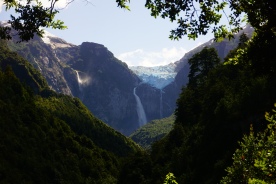The Carretera Austral and Patagonia are two resplendent names on the map of South America, but also the the regions around Temuco, Villarica and Puerto Varas on the Chilean side and San Martin de los Andes and Bariloche on the side of Argentina have a lot to offer. The southwest of the south-american continent is full of blue rivers, lakes, snow-covered mountains or volcanoes and besides cycling there are a lot of trekking options to discover the beautiful nature.
It will be to much to write about everything what I experienced between Santiago and Rio Gallegos, so I decided to pick some of the highlights.
Parque Nacional Conguillío
The name Conguillio originate from the language of the Mapuche people and means water with pine kernel. In the center of this lovely national park is on of the highest volcanoes of this region, called Llaima. In winter it is used for skiing and in summer you can follow the hiking trails passing the high and impressive araucaria trees, nice lakes and cooled lava.
When I entered the park, the volcano was hidden behind clouds, but anyway it was a nice ride and at the end I could see it from the distance while cycling further south.
Villarica and Pucon
When one volcano was not seen anymore, the next one was waiting around the corner. Villarica and Pucon were two nice little cities at the lake Villarica. Between the both I camped directly next to the lake and refreshed myself in the water after a sunny cycling day.
From Pucon I went to some waterfalls and the Ojos del Carburga, a spring pool of a subterranean river, where the water was extremely clear.
Ruta de los 7 lagos, between San Martin de Los Andes and Bariloche
After I left Pucon, I crossed the border to Argentina, where I passed another imposing volcano. A nice welcome present was the free campground just behind the border. Further south I entered the famous ruta de los siete lagos, which has its name from the seven lakes which are between San Martin de los Andes and Bariloche. In this region people from Chile and Argentina spend their holidays.
Bariloche itself wasn’t that nice for me. An ugly town, whose waterfront at the lake Nahuel Nuapi doesn’t invite myself to spent some time. Much more attractive were the numerous mountains in this area, where I decided to discover Cerro Lopez and spend a night at the Refugio. The view was incredible and by looking out of my tent I had an overview over a landscape full of lakes.
Puerto Varas and Isla Chiloe
From Bariloche I headed to Chile again, crossing three lakes with ferries and riding my bike in between the ports. Although it was a little bit expensive it was worth it. On the boat I got to know Ruben, a Argentinian cyclist and in the evening I ended up camping with two more at the lake Llanquihue.
While waiting for a package from Germany I spent one week in Puerto Varas with Constanza, a Chilian girl. She also had some free time and so we discovered the surroundings and also spent two days on the island of Chiloe, where we went to see some penguins.
In this part of Chile and also in the region around Villarica I felt the strong German influence. The Chilian people also use the word Kuchen, which was sold in many places. In Villarica and in Pucon it was possible to buy german bread (panaderia Rostock) and along the streets I could see some german names as labels of different coffee places, restaurants or companies.
Carretera Austral
When I met some other cyclists travelling it was always something special, but the Carretera Austral was so full of them, that we even passed each other without having a conversation. After I left Puerto Varas, I entered the famous cycling route in Puerto Montt and followed it until their end in Villa O’Higgins.It took me about three weeks and most of the time I was cycling with Brian and Andrea, two americans and Jakob, a german. But every day I saw about 10 other cyclists and the ones cycling the same direction were met over and over again.
It was a great time with a lot of wild camping, campfires, dirt roads and a predominant green landscape. One highlight was the hiking of Cerro Castillo, a impressing mountain range, which looks like a castle.
When we arrived in Villa O’Higgins, we were informed that one boat had a hole and needed some time to be rebuilt. Furthermore, due to bad weather conditions, no boat was allowed to cross the lake to Argentina for a few days, so that we met a lot of cyclists (maybe around 40 ) at the campsites in this tiny village, all waiting for the next chance to go on with their travels.
After four nights it was our turn to enter the boat. Afterwards we heard, that the repaired boat of Robinson Crusoe sank, because it hit a iceberg. The passengers needed to be rescued by a helicopter.
Patagonia
My time in Patagonia was dominated by some hikes, beautiful mountains and glaciers. I spent more days hiking than cycling and enjoyed to have some more variety.
Before we reached El Chalten, starting point to hike around the Fitzroy mountain, we had two cycling days with a 6 kilometer section, which is rather suited for walking. But for us it was a welcome relief and another little adventure. Over trunks and stones,through mud and narrow paths it was a very nice part. And after we finished this section we arrived at Lago Del Desierto, where we camped next to the lake and enjoyed the view over the water and the Fitzroy in the background.
The hike over the paso del viento around the mountain Huemul was definitely one of my hiking favorites. With 11 other cyclists and one german backpacker we had four beautiful days in the mountains, walking over glacier ice, astonished by the huge ice field and observing swimming icebergs.
Cycling out of El Chalten I got to know the face of the Pampas with nearly no trees but thousands of yellow shrubs.But not just the colour changed,but also the intensity of the wind. With a solid tailwind I was pushed east, while some days later I was confronted with a head wind, which I had totally underestimated.
Every 3-6 years there is a special natural event happening at the glacier perrito moreno. Due to the climate change most glaciars are shrinking, but this was near El Calafate is growing. The ice wall of a height of around 60 meters is moving forward until it reaches a peace of land on the other side. That leads to a congestion of the meltwater on one side. When the pressure gets to strong, the water pave itself a way under the ice, a hole which gets bigger and bigger until a ice bridge is produced. Due to the weight of the ice bridge and the flowing water underneath, it leads to the point where this bridge breaks and falls into the water. On that day, when this spectacular took place again, I visited the glacier, but unfortunately 40 minutes too late. Anyway, it still was impressing to see this long huge wall of ice and from time to time other big parts fell into the water with a loud crashing noise.
Along my way down south I heart of the beauty of Torres del Paine over and over again and I was aware that it was full of tourists. But most of the time there is a reason for the tourists and Torres del Paine is definitely worth to go although the treks are really full. From some locals I got to know that the airport will be opened to international flights in the next year and the park rangers talked about an increase of 30% compared to last year. I hitchhiked from Puerto Natales and was give a ride by a immigration officer and a family, which first took me to some places off the beaten track and then gave me some snacks and drinks for lunch.Most of the time it’s really worth to hitchhike. For the hike itself I decided to do the shorter „W“-Trek, which included most of the highlights.
With a beautiful ride with the wind in my back I cycled the last two days of my trip from Puerto Natales to Rio Gallegos. It was a lonesome part of the ruta 40 with nearly no cars.I was singing loud with the songs I was listening to, I was observing the wild life around me and I felt happy to have done this amazing tour.






























































Congratulations on completing your journey! I had so much fun following along online since we met at the coffee shop in Medellin.
The photos are absolutely stunning. Best of luck in whatever comes next. Drop me a line if you want to bike in SE Asia – I am about to move to Myanmar. Twitter: @ dustinbpalmer email: dbpalmer 4 [at] g m a i l [dot] com.
LikeLike